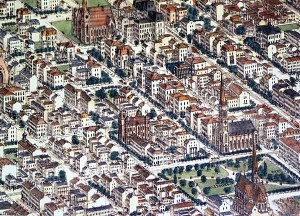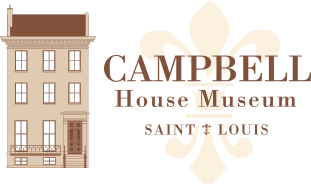Neighborhoods are an integral part of St. Louis.
We develop a sense of who we are by the boundaries of our neighborhood (i.e. where we shop, where we work, etc.).
For the Campbells, their neighborhood defined their standing in society. Lucas Place was the first private neighborhood in St. Louis. Its boundaries were clearly marked by street names and house numbers. Today, the neighborhood boundaries are more blurred. It is not uncommon for next-door neighbors to define their neighborhood very differently.
By studying the boundaries (physical, intellectual and social) of neighborhoods like Lucas Place, students gain a greater understand of their own, which will aid in later studies of city growth and neighborhood evolution, helping students find their place in St. Louis.
Some goals of the Museum’s Neighborhood Lesson Plan:
- Develop critical thinking skills
- Recognize street names and their association with each other
- Obtain a basic understanding of how a neighborhood relates to greater St. Louis.
- Recognize a sense of ownership for familiar places (i.e. this is my neighborhood’s store; this is our library, etc.)
- Develop a sense that individual action can make a difference.
After completing the program, students should be able to answer the following questions:
- What makes up a neighborhood? What do you need to have a neighborhood?
- What typically defined a neighborhood like Lucas Place? What defines a neighborhood now?Why was Lucas Place built?
- Who moved into Lucas Place?
- Where did people live before neighborhoods like Lucas Place were built?
- Where did other people live since they could not afford to live in Lucas Place? Did they still live in a neighborhood?
- What do you see happening around the Campbell House neighborhood today?
- Has the function of a neighborhood changed? Is it still changing?
- What is happening in your neighborhood today? How is it changing?
Common Core standards for this lesson: RH.6–8.1, RH.6–8.7, RH.6–8.8, RI.6.3, RI.6.7, speaking elements: SL.6.2 to SL.8.2, SL.6.4 to SL.8.4, collaborations: SL.6.1a‑d to SL.8.1a‑d.
This program has been created with a grant from the Whitaker Foundation.

Procedures to be completed BEFORE visiting the Museum:
Step 1
Provide School Picture
The school must provide a picture of the school, either a photograph or drawing (approximately 3.5 inch by 5 inch).
Step 2
Consider These Questions
Before visiting the Campbell House, the students need to individually answer (or be thinking about) the following questions:
- Who lives in your neighborhood? How far away do these individuals live from you (i.e. two blocks, two houses, across the hallway [apartments], etc.)?
- What are the boundaries of your neighborhood (i.e. buildings, Mr. Jones’ house, street names, etc.)?
- What is needed to make up a neighborhood? Do you need stores, houses, playgrounds or a mixture? Do you need a lot of people?
- What street do you live on (NOT the house number)?
It is not necessary for the students to actually write their responses before visiting the Campbell House. However, it is important that they review the questions prior to their visit. The students will be asked to write their responses at the Campbell House. We strongly encourage students to express their ideas with words, art and/or poetry.
Procedures to be completed at the Museum:
Step 1
Describe Your Neighborhood
Each student is given one page (front and back) that they may use to independently describe their neighborhood. Before asking the following questions, remember to ask the students to leave a small portion of their page empty. It does not matter which portion they leave empty. However, they need sufficient space to answer the final question (see question in bold below). The students are asked the same questions they discussed in their Pre-Visit activity:
- Who lives in your neighborhood? How far away do these individuals live from you (i.e. two blocks, two houses, across the hallway [apartments], etc.)?
- What are the boundaries of your neighborhood (i.e. buildings, Mr. Jones’ house, street names, etc.)?
- What is needed to make up a neighborhood? Do you need stores, houses, playgrounds or a mixture? Do you need a lot of people?
After ample time has passed (approximately 25 minutes), students are asked to answer the following question for the booklet: “How can you tell you are no longer in your neighborhood?” As a group, the students are encouraged to share their responses.
Step 2
Campbell House Neighborhood Discussion
After we discuss the students’ responses, the Instructor begins to answer the same questions for the Campbell House neighborhood, Lucas Place:
- Why was Lucas Place built? What were the boundaries of Lucas Place?
- Who moved into Lucas Place?
- Why, do you think, people moved into Lucas Place?
- What type of buildings made up Lucas Place (i.e. houses, churches, etc.)?
(The discussion of the Campbell House neighborhood [What makes up Lucas Place?] takes place AFTER the students give their responses because we do not want to influence these responses.) The Instructor will use illustrations and maps to describe Lucas Place in 1875. In addition to buildings, the Instructor will point out the various people that lived in Lucas Place, such as Robert Campbell.
Step 3
Discussion of other Neighborhoods
Lucas Place was one of the first neighborhoods of its kind built in St. Louis. The Instructor should begin a discussion of other neighborhoods. The discussion should answer the following questions:
- Where do other people live, if they were unable to afford a home in Lucas Place?
- Did they still live in neighborhoods? Why or why not?
- How is Lucas Place different from other neighborhoods? How is it the same?
- Where did people live before places like Lucas Place were built?
Step 4
What Makes Up A Neighborhood?
After the discussion of Lucas Place, the Instructor will draw the discussion back to “What makes up a neighborhood?” The Instructor should compare and contrast the individual answers and follow with the statement such as, “Everyone views their neighborhood as providing for their individual needs. For example, Mary may need to buy groceries more often than Bobby. So, Mary might define her neighborhood with grocery stores. Yet, Bobby does not need groceries as often, since he eats out so much. So, he might define his neighborhood with restaurants instead of grocery stores.” This discussion should then lead into the purpose/function of Lucas Place. And, the students are invited to share what is special about their neighborhood.
Next, the students are shown an official map of their school district, provided by the St. Louis Public School system. The students should recognize right away that the “official” boundaries of their neighborhood differ drastically from their own descriptions. However, to visually aid the students, the Instructor will use pushpins to mark the location of the school and the individuals’ homes. Note: The individuals should only provide their street name NOT their house number. Each location is represented by a different color. For example, the houses’ locations are marked with red pushpins, while the school’s location is marked with a yellow pushpin. Be sure to indicate which color represents which location.
(For this exercise, the map is adhered to foam core. Also the exact location of the student’s home is not important. The idea is to show the relationship between the residential and the business/commercial aspects of a neighborhood. Another purpose of locating the homes is to show how neighborhoods change over time. For example, the Campbell House once set in the middle of an elaborate, residential neighborhood. It now rests in the midst of Downtown St. Louis, surrounded by both residents and businesses.)
Next, the Instructor will begin the discussion by stating: “The St. Louis Public School system had a map that differed from your descriptions/boundaries. Why is that, or why would the boundaries differ? What function do these boundaries perform? What function do the boundaries of your neighborhood perform?” (Open)
Finally, the Instructor uses a different color pushpin (i.e. green) to mark the various historic buildings/monuments/parks within the school’s neighborhood (the “official” boundaries are used for this exercise). Note: The historic landmarks are determined before the program takes place. However, if the teachers know of a landmark that is special to the school, they are welcomed to share this information before visiting the Campbell House. This exercise leads into the next step’s discussion on neighborhood change (what is now considered “historic” was once a brand new building).
Step 5
Discussion on Neighborhood Change
While the Instructor begins the discussion on neighborhood change, the individual booklet pages are collected and bounded with a brief description of Lucas Place in 1875. At this point, it is important for the Instructor to show the students pictures of Lucas Place in 1875 and current images. This way, students can compare and contrast the two “neighborhoods.” They can see for themselves the changes that took place over time.
The Instructor will begin the discussion by asking:
- What do you see happening around the Campbell House today? Has the function of Lucas Place changed? Is it still changing?
- How do these changes affect the function of the Campbell House (i.e. it was once a residence, and is now an historic house)?
- What is happening in your neighborhood today? How is it changing? (Open)
- Do you see the same type of changes for buildings like the Campbell House (or insert an historic building/park)?
The Instructor will then end the discussion by suggesting that when the students go home today, they talk with their parents/guardians, neighbors and teachers about the changes in their neighborhood. Then, compare those changes with ones you see in Lucas Place. Finally, do you see other neighborhoods changing? How are they changing?
Step 6
Group Photo
Before the students leave, a photograph is taken of them in front of the Campbell House. This photograph is then inserted into a photo jacket on the inside of the rear booklet cover. The booklet is then given to the teacher to take back to the classroom. (The booklet is bounded in a fashion that allows the teacher to redistribute individual pages.)
